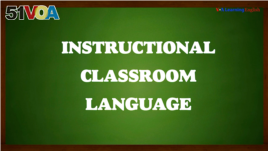11 July 2023
Teachers everywhere do something every day – they give instructions. We sometimes call this "instructional classroom language."
Some instructions help to manage a class. Other instructions explain how to do an activity -- like a game or art project. This article gives tips on how to do both in English.
General classroom management

Early Literacy: Instructional Classroom Language
Greet your students in English.
In the morning, as your students enter the classroom, greet them in English. Say things like: "Good morning!" "Please come in!" "How are you?" Change the greetings often. This way your students will learn many ways to greet people in English.
Identify things you do every day.
Teachers know that routines are important for classroom management. Teachers can identify their own activities that are done every day such as welcoming students to class, taking attendance, or stating the goals of the day. Using English for these daily routines can help increase your students' English skills and confidence.
Write down common instructions in your classroom.
Identify the most common routines, write them down, and post them in your classroom. Seeing them every day may help students. Students might also be able to lead some routines, like taking attendance.
Use body language.
When managing a class in English, use body language. For example, when you say, "listen to me," you can point to your ear. And if you say, "raise your hand," raise your hand.
Activity instructions
When you teach an activity, give clear instructions. If students do not understand, they will be unable to do the activity. But giving instructions is not easy. It takes practice. Many native English teachers and experienced teachers can have trouble giving clear instructions. But following a few tips can help.
Generally, giving instructions for activities follows three steps:
Step 1. Prepare
Step 2. Deliver
Step 3. Monitor
Step 1. Prepare
First, plan what to say and then write it down.
Before your class, practice alone, with a friend, or with your partner teacher. This can help you find problems or preparations you may have forgotten. It can also help you to feel more confident.
Hand out materials after you give instructions (usually.)
Some materials, like crayons and paper, could distract students. This means you have lost their attention. However, if students need the materials to understand the instructions, hand the materials out before.
Arrange the classroom or students before giving instructions.
Move around desks or chairs in the classroom or group your students before you give instructions. After moving around, the students may forget the instructions.
Group students yourself.
Unless it is part of a lesson, grouping students yourself can save time. It will also allow you to partner students based on their abilities.
Step 2. Deliver
Get the attention of all your students.
Before you start, make sure all of your students are listening. It is important to have their attention.
Speak simply, clearly and with emotion.
When you give instructions in English, use simple language, and pause often. When you stop, your students have time to think about the instructions. Change your voice. Make it go high or low as needed.
Use body language, objects and other visual aids.
Body language helps when giving instructions. Objects and other visual aids help too. For example, if you tell your students to use a pencil, show them a pencil.
Do not give long instructions all at once.
If an activity has many steps, do not give all of the instructions at one time. If you give all of the instructions at once, students may forget some of them.
Set a time limit for the activity.
Time limits are very important. Students need to know, "How much time do I have to finish this activity?" Time limits allow students to pace themselves.
Model the instructions - show them how.
It is a good idea to model the instructions with a student or partner teacher. This is a good way to show the activity in action.
Make sure all students understand.
Now, after giving instructions, you need to find out if your students understand. But do not ask, "Do you understand?" Students might not want to say that they don't understand. Or they might think they understand, but they do not.
Instead, you can ask a few students to explain the instructions in their own words. Or you can pick two or three students and ask questions about the instructions.
Step 3. Monitor
As your students do the activity, walk around and watch. If they are having a hard time, stop the activity. Repeat any part of the instructions to certain students, or you may have to give all the instructions to the whole class again. However, if the students are having trouble with the activity, move on to something else.
Monitor yourself
After you give instructions and the students are doing the activity, make some notes. What went well? What did not go well? What could you change or add to make it better?
Monitor other teachers
Teachers can watch each other give instructions. Then they can give feedback. This is a form of peer review. If possible, teachers can record a video. Teachers can watch to see what worked or what did not.
These tips are suggestions and in some cases reminders. Teachers can change or add to them based on their own situation. Teachers can keep a list of tips and add to them as they discover their own.
I'm Anna Matteo.
And I'm Caty Weaver.
Anna Matteo wrote this lesson for VOA Learning English. It is part of a series on Early Literacy.
__
Words in This Story
routine – n. something that is done regularly
take attendance – v. the record who is attending a class and who is not present
confidence – n. a feeling of trust or belief
distract – v. to draw or direct (something, such as someone's attention) to a different object or in different directions at the same time
pace – v. rate of progress
feedback –n. helpful information or criticism aimed at improving a person's performance
peer review – n. a formal process in which a group of experts check a study meant for publication to make sure it meets requirements for professional publication and quality












